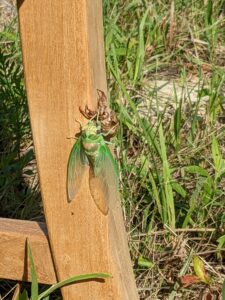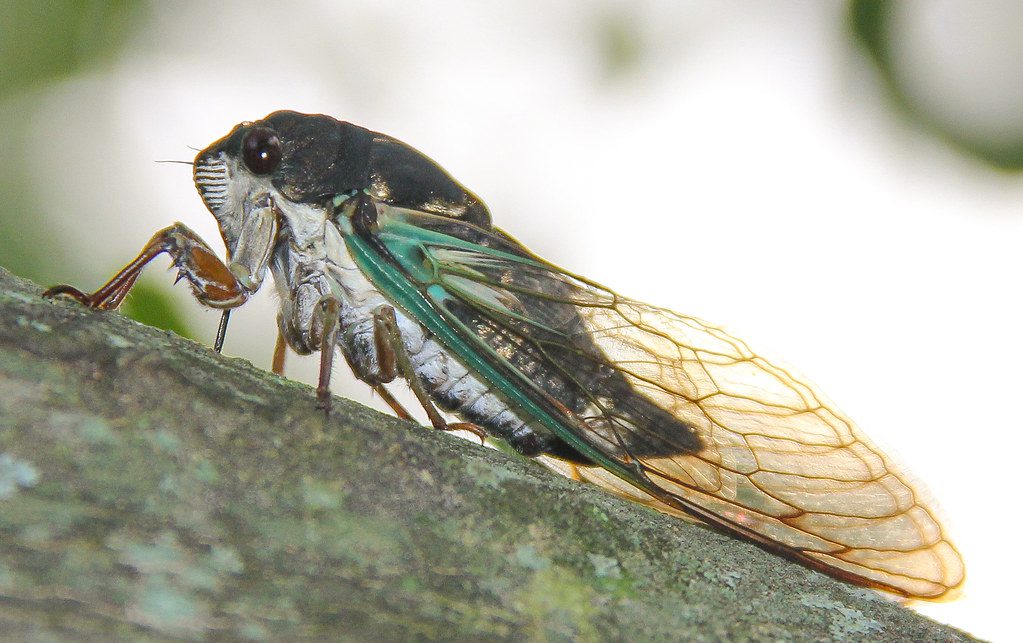The Buzz About These Bugs
by Jen Rowray
I am so excited for the upcoming double cicada hatching in the spring of 2024!
On an average year we get tens of thousands of cicadas per acre. This year it can be over 1.5 million per acre in some counties. The congregational singing is going to equal that of a chainsaw less than three feet away from your ear. I, for one, cannot wait. They mostly make noise at night, replacing the quiet evenings of summer with buzzing that is so loud we have to talk over it to have a conversation.
The ground will be warming soon and the double hatching of broods 2013 and 2017 will begin so I encourage you to be on the lookout for those shedding their shells. Kids and adults alike will enjoy the experience. The birds and small mammals like foxes and raccoons will be feasting on the shells and the bugs themselves. An all you can eat buffet provided by nature. Feel free to crunch on a few yourself if you are brave enough. I hope you will sit outside and let the world slow down around you while you listen to their song. See if you can tell where they are gathering in your yard or use the sounds to pinpoint one and see if you can catch him singing his best mating call.
When I was a kid I delighted in finding the weird empty shells of these odd-looking insects. They were “sticky” and could be affixed to my shirt, or even better, the shirt of an unsuspecting friend. I would sneak it to her shoulder and then just watch and wait. If she took too long to notice I would finally say “What is that on your shoulder?”, then sit back and watch the screaming and running. All that thrill and laughter for free.
We would look all over for them and my dad taught us to check by exposed tree roots, especially the big maple in our yard. The little shells made great specimens for Show and Tell the next school year. We kept them safely in old baby food or peanut butter jars and our classmates would ooh and ahh at the funny little empty bodies.
 There are so many questions that adults have when they stumble up the remnants of a cicada who has grown, shed and moved on to make more cicadas. Do they bite? Where did the bug go? Why is it not falling apart like a dead body? No they don’t bite. They have to shed because their outer skin is hard so to get bigger they must climb out of the smaller one they lived in underground. The skin is made up of a substance called Chitlin. It is hard, durable, see through AND (this is my favorite part) they are edible. Fun Fact: it is the same material used to make some surgical sutures because it biodegrades over time.
There are so many questions that adults have when they stumble up the remnants of a cicada who has grown, shed and moved on to make more cicadas. Do they bite? Where did the bug go? Why is it not falling apart like a dead body? No they don’t bite. They have to shed because their outer skin is hard so to get bigger they must climb out of the smaller one they lived in underground. The skin is made up of a substance called Chitlin. It is hard, durable, see through AND (this is my favorite part) they are edible. Fun Fact: it is the same material used to make some surgical sutures because it biodegrades over time.
When I was about 13 we were having a water fight. We heard the buzzing at night but it seemed like just part of early summer and didn’t really ask what made them or why. I had just tossed a large bucket of cold well water on my nephew who was about 5 years my junior. I was pretty confident he could not carry a heavy bucket and catch me. He grabbed a hose and, thinking I was clever, I just stepped behind the trunk of a big tree. He stood there, staring at me and then, he looked up. We made eye contact and he looked up again. I wondered “What is he looking at up there?”
While I was still processing he aimed the hose into the tree branches and just as the water left the end of the hose I understood what was happening. A hoard of sticky, wet and creepy cicadas rained down on me and my unsuspecting friend who was standing nearby. The only thing louder than the decibels of those night time cicada choirs was the screaming of two teen girls as we ran front the scene of the crime removing t-shirts and shaking out our hair as we went. It is a trauma that lives with me and evokes the heebee jeebees but also the fondness of childhood wildness.
Just a few summers ago a friend and I were camping and came across a newly emerged cicada. She was shedding her exoskeleton, a sight neither of us had ever witnessed. We knelt and watched as she slowly crawled out, bright green and wings all tucked up to her body. “What is that?” other passerbyers asked. I was only sure she was a cicada because of all the shells I have found and collected through the years. “A cicada” I answered in hushed tones. “Why are you whispering?” said my friend. “I don’t know. Just feels like she is working hard and I don’t want to break her concentration” She side eyed me and stated “Fair.”
We watched with a gathering crowd as she worked free and began to spread her almost clear wings. The translucent pattern began to darken in the sunlight and her coloring followed. She flapped her wings and moved her head, like she was stretching. She had a busy few weeks ahead, an important mission to find a boyfriend and lay eggs to ensure her species will continue to amuse and creep people out for generations to come.
This will be the largest hatching in 208 years, with the last happening in 1803! Billions of bugs will be emerging soon and I hope you can take some time to appreciate nature’s beauty and noise. But don’t stand under a tree before you check it. If you insist on scaring your friend with one at least get it on video so we can all enjoy the running and screaming.
A few of my favorite cicada facts:
- Cicadas are NOT locusts and do not cause crop or garden damage
- They can harm very young or weak trees (mostly from weight) so cover saplings
- They provide a protein-rich food source for many animals coming out of winter and ready to pack on some weight
- Some cicadas can have red eyes (for extra creep factor)
- The females tend to be larger than the males
- The males song is called a “congregational song” or “chorus”
- People that are allergic to shellfish should not eat them
- Both males and females make a sound but females click their wings while males pretty much scream into the night by vibrating a part of their abdomen called tympana
Links for the endlessly curious:
https://www.smithsonianmag.com/science-nature/14-fun-facts-about-cicadas-180977361/
https://www.almanac.com/double-brood-cicadas-coming-2024-see-cicada-map-and-more-facts


1 Comment. Leave new
Children and educators looking to explain the periodical cicadas can check out the book Cecily Cicada, which has a special double brood edition available this year! 🙂
https://www.amazon.com/Cecily-Cicada-Special-Double-Brood/dp/B0CW3786VW